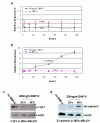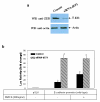BMP-6 promotes E-cadherin expression through repressing deltaEF1 in breast cancer cells
- PMID: 17997862
- PMCID: PMC2217560
- DOI: 10.1186/1471-2407-7-211
BMP-6 promotes E-cadherin expression through repressing deltaEF1 in breast cancer cells
Abstract
Background: Bone morphogenetic protein-6 (BMP-6) is critically involved in many developmental processes. Recent studies indicate that BMP-6 is closely related to tumor differentiation and metastasis.
Methods: Quantitative RT-PCR was used to determine the expression of BMP-6, E-cadherin, and deltaEF1 at the mRNA level in MCF-7 and MDA-MB-231 breast cancer cells, as well as in 16 breast cancer specimens. Immunoblot analysis was used to measure the expression of deltaEF1 at the protein level in deltaEF1-overexpressing and deltaEF1-interfered MDA-MB-231 cells. Luciferase assay was used to determine the rhBMP-6 or deltaEF1 driven transcriptional activity of the E-cadherin promoter in MDA-MB-231 cells. Quantitative CHIP assay was used to detect the direct association of deltaEF1 with the E-cadherin proximal promoter in MDA-MB-231 cells.
Results: MCF-7 breast cancer cells, an ER+ cell line that expressed high levels of BMP-6 and E-cadherin exhibited very low levels of deltaEF1 transcript. In contrast, MDA-MB-231 cells, an ER- cell line had significantly reduced BMP-6 and E-cadherin mRNA levels, suggesting an inverse correlation between BMP-6/E-cadherin and deltaEF1. To determine if the same relationship exists in human tumors, we examined tissue samples of breast cancer from human subjects. In 16 breast cancer specimens, the inverse correlation between BMP-6/E-cadherin and deltaEF1 was observed in both ER+ cases (4 of 8 cases) and ER- cases (7 of 8 cases). Further, we found that BMP-6 inhibited deltaEF1 transcription, resulting in an up-regulation of E-cadherin mRNA expression. This is consistent with our analysis of the E-cadherin promoter demonstrating that BMP-6 was a potent transcriptional activator. Interestingly, ectopic expression of deltaEF1 was able to block BMP-6-induced transactivation of E-cadherin, whereas RNA interference-mediated down-regulation of endogenous deltaEF1 in breast cancer cells abolished E-cadherin transactivation by BMP-6. In addition to down-regulating the expression of deltaEF1, BMP-6 also physically dislodged deltaEF1 from E-cadherin promoter to allow the activation of E-cadherin transcription.
Conclusion: We conclude that repression of deltaEF1 plays a key role in mediating BMP-6-induced transcriptional activation of E-cadherin in breast cancer cells. Consistent with the fact that higher level of deltaEF1 expression is associated with more invasive phenotype of breast cancer cells, our collective data suggests that deltaEF1 is likely the switch through which BMP-6 restores E-cadherin-mediated cell-to-cell adhesion and prevents breast cancer metastasis.
Figures








Similar articles
-
Dual mechanism of deltaEF1 expression regulated by bone morphogenetic protein-6 in breast cancer.Int J Biochem Cell Biol. 2009 Apr;41(4):853-61. doi: 10.1016/j.biocel.2008.08.030. Epub 2008 Sep 2. Int J Biochem Cell Biol. 2009. PMID: 18805502
-
BMP-6 inhibits microRNA-21 expression in breast cancer through repressing deltaEF1 and AP-1.Cell Res. 2009 Apr;19(4):487-96. doi: 10.1038/cr.2009.34. Cell Res. 2009. PMID: 19308091
-
δEF1 associates with DNMT1 and maintains DNA methylation of the E-cadherin promoter in breast cancer cells.Cancer Med. 2015 Jan;4(1):125-35. doi: 10.1002/cam4.347. Epub 2014 Oct 15. Cancer Med. 2015. PMID: 25315069 Free PMC article.
-
Molecular mechanisms controlling E-cadherin expression in breast cancer.Biochem Biophys Res Commun. 2009 Jun 19;384(1):6-11. doi: 10.1016/j.bbrc.2009.04.051. Epub 2009 Apr 18. Biochem Biophys Res Commun. 2009. PMID: 19379710 Free PMC article. Review.
-
Discovery of Inverse Agonists for the Liver Receptor Homologue-1 (LRH1; NR5A2).2010 Oct 12 [updated 2011 Dec 12]. In: Probe Reports from the NIH Molecular Libraries Program [Internet]. Bethesda (MD): National Center for Biotechnology Information (US); 2010–. 2010 Oct 12 [updated 2011 Dec 12]. In: Probe Reports from the NIH Molecular Libraries Program [Internet]. Bethesda (MD): National Center for Biotechnology Information (US); 2010–. PMID: 23166964 Free Books & Documents. Review.
Cited by
-
Upregulated bone morphogenetic protein 8A (BMP8A) in triple negative breast cancer (TNBC) and its involvement in the bone metastasis.Front Cell Dev Biol. 2024 Jul 19;12:1374269. doi: 10.3389/fcell.2024.1374269. eCollection 2024. Front Cell Dev Biol. 2024. PMID: 39100096 Free PMC article.
-
Increased origin activity in transformed versus normal cells: identification of novel protein players involved in DNA replication and cellular transformation.Nucleic Acids Res. 2010 Apr;38(7):2314-31. doi: 10.1093/nar/gkp1192. Epub 2010 Jan 11. Nucleic Acids Res. 2010. PMID: 20064876 Free PMC article.
-
ZEB1 confers chemotherapeutic resistance to breast cancer by activating ATM.Cell Death Dis. 2018 Jan 19;9(2):57. doi: 10.1038/s41419-017-0087-3. Cell Death Dis. 2018. PMID: 29352223 Free PMC article.
-
Lentivirus-delivered ZEB-1 small interfering RNA inhibits lung adenocarcinoma cell growth in vitro and in vivo.J Cancer Res Clin Oncol. 2012 Aug;138(8):1329-38. doi: 10.1007/s00432-012-1206-2. Epub 2012 Apr 6. J Cancer Res Clin Oncol. 2012. PMID: 22481253 Free PMC article.
-
Methylation signature of lymph node metastases in breast cancer patients.BMC Cancer. 2012 Jun 13;12:244. doi: 10.1186/1471-2407-12-244. BMC Cancer. 2012. PMID: 22695536 Free PMC article.
References
Publication types
MeSH terms
Substances
LinkOut - more resources
Full Text Sources
Medical
Miscellaneous

